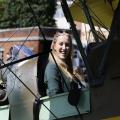ON MAY 20, 1940, Colonel Lloyd Mostyn was appointed officer commanding of the newly raised Bicester Company of the Local Defence Volunteers (later renamed the Home Guard).
Other appointments, were Mr H.Morgan [Bicester section], Mr E.Chinnery [Finmere], Mr P.Hodgson [Fritwell], Mr N.Patterson [Launton].
It should be noted that none of these section leaders had a military rank.
At this early period, the LDV was considered a purely amateur organisation and as such, not part of the military, it was not until April 1941 that officers received military commissions.
By then, Major Fane was in command, and sections had grown to become platoons, commanded by Captains or Lieutenants.
The first headquarters was the Lodge at the Garth. Other buildings used during the war included, perhaps a popular one, the Bell public house in Sheep Street.
In June 1940, anti tank defences were set up on all roads leading to Bicester. These included concrete cylinders that could be rolled into the road to block it.
In the beginning, all weapons were privately owned and it would not have been unusual to see members on patrol, armed with pitchforks, or even a bread knife fixed to a broom handle.
However, at the beginning of June 1940, a small number of rifles had arrived, in July, a few more.
In August, the Bicester Battalion, had 740 American rifles, by November, more rifles had arrived, plus five Vickers machine guns and 29 Lewis machine guns.
Over the following year, 60 American Browning automatic rifles, 42 Tommy guns (later replaced with British Sten Guns) and 15 grenade launching Northover projectors were added.
Throughout the war years, the Bicester Home Guard trained and took part in numerous exercises.
In September 1940, the Bicester Company defended the town against an 'invasion' by the Woodstock Company.
Section A defended the Bucknell Road, but failed to stop the enemy getting through, as did D section defending Oxford Road. C section did better, stopping the attackers on the London Road.
There were also church parades, and annual parades on the anniversary of the group's formation, with the Home Guard marching through the town to the Market Square where the salute would be taken.
The Home Guard was not all training and parades, there was a strong social element.
As well as family get to togethers, Bicester Company produced teams for football, cricket, darts, snooker, and rifle shooting.
Although they had mixed results in most events, they excelled at target shooting, beating the local police and Army units on many occasions.
Perhaps that is not surprising when you consider that many of their members were from the local rifle club or were soldiers from the Great War.
There were bad times though.
John Caswell was leading a night patrol on bicycles, when they were hit by an army lorry in darkness, sadly he lost his life.
Another loss to the company, was a Mr Henderson, knocked down on the new bypass.
His son was a pilot officer, who had been killed at Dunkirk.
The wartime blackout restrictions on vehicles cost many lives and Home Guard members on night patrol were very vulnerable.
In 1942, conscription to the Home Guard was introduced.
This caused some friction with those who had volunteered in the early days and who felt that the new arrivals were not keen enough.
At the end of 1944 it was decided that the Home Guard should stand down.
It was stated, that of the original volunteers from May 1940, 19 were still with the company.
For more information on our living history group visit oxfordshirehomeguard.uk






Comments: Our rules
We want our comments to be a lively and valuable part of our community - a place where readers can debate and engage with the most important local issues. The ability to comment on our stories is a privilege, not a right, however, and that privilege may be withdrawn if it is abused or misused.
Please report any comments that break our rules.
Read the rules here